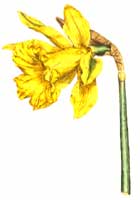** Warning: The following blog entry is full of aggravation and plant augish. Caution advised**
So I thought it was the bunny who has been nibbling this and that in the front but was puzzled why Ms. Fuzzytail didn't eat what she was tasting. Perhaps she realized that she didn't like onion afterall, or thought it would give Peter and the little ones indigestion? So I errected a fence.
Over the next couple weeks, one of my two onion* patches was decimated, most of my leeks were gone and there was nary a parsnip to be seen, nor a radish (I only plant these for show so I wasn't all that upset). I was puzzled.
Then I found a grayish fat grub chomping on an onion early in the morning. It dawned on me that I had heard of this menace before. The name crystalized in my head... cutworm.
Looking up the description confirmed it.
Hortiphilia Fact
Cutworms are the immature stage of several species of brown moth. They generally cut leaves or the entire plant off near the ground, leaving the victem lying beside the denuded stem. They are most commonly fat, dirty grey in colour and curl into a C shape when picked up.
I was overtaken with horror. What was the solution? I tried eggshells but the ants carted them off. Iwent to buy some
Diamotaceous Earth but it read don't use on food. I thought of
Bacillus Thuringiensis but didn't want to hurt any beneficials and other non targets. I stuck a stick in the ground beside the plant stem and they thanked me for the boost. Finally I wrapped the stems of my peppers (budding and fruiting!) in aluminium foil. So far, so good.
I also discovered that if you scratch the ground near by the latest casulty, the bleeping thing is very close by snoozing a way. It then goes to sleep with the fishes in my pond...
Normally, I am a live and let live kinda gardener but come on, I have only seven parsnip seedling left! Apparently you can also lay boards near where they are feeding. They will hide underneath and you can surprise them in the morning with your pail of soapy water (for tossing them in). I have heard people also have success with rings of cornmeal, eggshell or other scratchy stuff.
The best technique though is seclusion. Keep your plants away from them! They are often found in new garden beds where there was once sod but not exclusively. What do I mean?
Procedure for collaring plants:1. Take something flexible that you can make a 3 inch collar out of like aluminum, toilet paper roll, plastic, whatever.
2. Place around stem while planting, 1 inch below the soil, 2 inches above.
3. For large areas, try garden edger.
You can also culivate shallowly in the spring and let the birds make a meal of them before planting.
Soon, I'll show you my seed starting setup to replant the devastated area.
* They arem't supposed to like onions... mine aren't so picky.**
Where are the pictures? My nifty camera is out for repairs so no closeups possible. LinksManaging CutwormsControlling Cutworms







